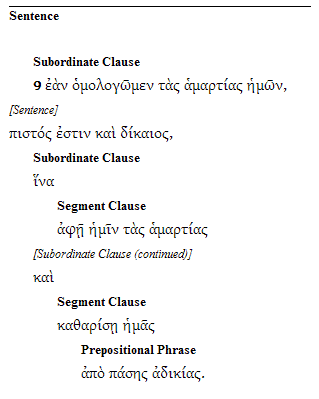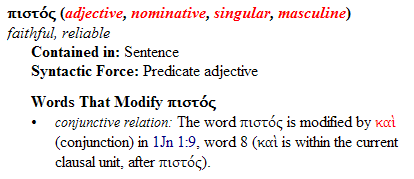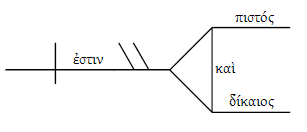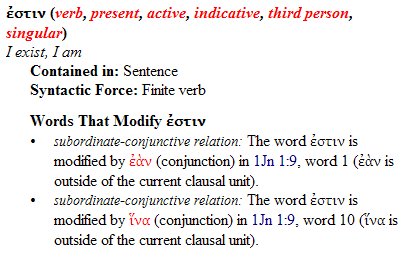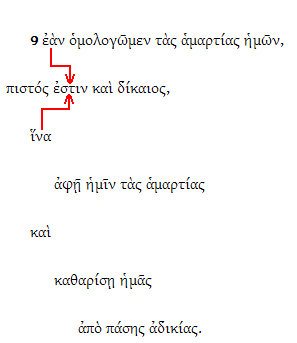Last week, I posted on the Lexham SGNT “running text”. I mentioned at that time that there are three primary pieces of the Lexham Syntactic Greek New Testament:
- The Lexham Syntactic Greek New Testament
- The Lexham Syntactic Greek New Testament: Sentence Analysis
- The Lexham Syntactic Greek New Testament: Expansions and Annotations
Today it is time to look at the Expansions and Annotations resource. This resource is still in a state of flux, so the implementation may change somewhat between now and the time that the Lexham SGNT is released.
The Lexham SGNT: Expansions and Annotations attempts to convey relationships between words in a textual manner. The concept is to provide text for each word detailing the word’s position in the current containing clause, explaining the word’s syntactic force, and listing the relationships the word has with other words.
If we look at 1Jn 1.9 in the Lexham SGNT, we see the following clausal structure breakdown:
We look for the leftmost pieces to see the “top” piece(s) of the clause. In this case it consists of the phrase ?????? ????? ??? ???????. But what about the role each of those items plays in the sentence at hand?
This information is revealed using the Expansions and Annotations resource. Instead of starting with the first word in the sentence (???) let’s start with the first word in the sentence group, ??????. From the running text, I can access the Expansions and Annotations by:
- Hovering the mouse cursor over the word (assuming default keylink preferences)
- Keylinking on the word reference
- Right click | Selected References | GNT Word #NNNNNN | Lexham Syntactic Greek New Testament: Expansions and Annotations
There may be more, but those are the primary ways. Doing this will present the following information:
This information is structured as follows:
- ??????: The form of the Greek word as found in the Greek New Testament.
- (adjective, nominative, singular, masculine): The expanded parsing of this instance of the word. Each word that is red can be clicked or hovered for a short glossary definition of the morphological term.
- faithful, reliable: An expanded gloss providing a short definition of the word.
- Contained in: Sentence: This reflects the type of structure that immediately contains the word at hand.
- Syntactic Force: Predicate adjective: This is a description of the syntactic role that the word plays in this given instance. We anticipate a full glossary for these terms; implemented similarly to the way that the morphological terms above function. So one would be able to hover or click the text Predicate adjective and see a glossary definition/explanation of the term.
- Words that Modify ??????: This is a list of words that the Lexham SGNT has tagged as modifying ?????? (or whatever the current word is). In this case, the conjunction ??? is tagged as modifying ??????; the relationship between the two words is a conjunctive relationship. The reciprocal modifications are also noted; the Expansions and Annotations listing for ??? a few words later notes that is ?????? modified by ???.
So here’s what’s really going on with ?????? .. ??? ???????:
The conjunction ??? modifies both words by joining them into a unit. This unit functions as the predicate adjective. If we were doing a stick diagram (note: I’m largely self-taught here; you could diagram this differently) it might look like this:
Relationships between words outside of the immediate clausal structure are noted similarly. In this case, the word ????? provides an example. Here is the entry from the Expansions and Annotations resource:
Here you can see that two words; both of them conjunctions indicating a subordinate clause, are specified as modifying ?????. Again, the relationship can be thought of like the following:
You can probably also see that the ??? occuring later on in the clause functions similarly, modifying ??? and ????????. Looking up this ??? in the Expansions and Annotations confirms these relationships.
This is the sort of information that the Expansions and Annotations resource is intended to convey. Because language is messy, the relationships are messy and usually need a little explanation. Linguistic relationships aren’t necessarily structured. Some are (say, a relationship between a noun and its article) but others are much more … er … organic. The Expansions and Annotations resource provides more detail on all specified relationships, be the common or uncommon in nature.
Because this information is specified, it is also searchable. But this post is already running long; so look for a future post with examples of searching for these sorts of relationships.

